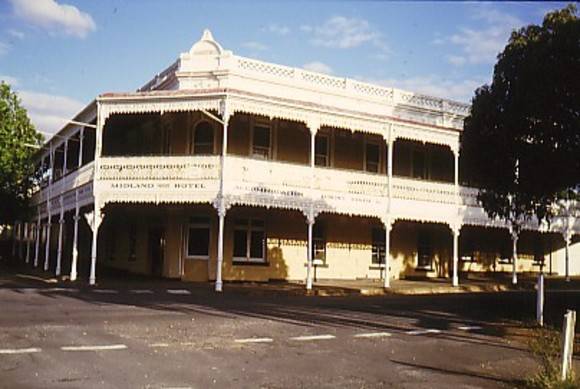| Back to search results » | Back to search page » |
|
Former Castlemaine Coffee Palace- Castlemaine Historic Area
Other NameMidland Private Hotel Location2 Templeton Street,, CASTLEMAINE VIC 3450 - Property No B2579
File NumberB2579LevelState |
|
Statement of Significance
Originating from a single-storey shop and dining room built for William Kort in 1879, this parapeted, two-storey and stuccoed brick building became the Castlemaine Coffee Palace after substantial extensions by builder Frank Corbel of Castlemaine in 1890.
Further sympathetic additions were made early this century whilst its conversion to the Midland Private Hotel c 1940 meant less appropriate superficial alterations to the entrance.
Architecturally the hotel is significant for its locally cast two-storey iron verandah, extending on both elevations form the corner splay, the dining room with its coved ceiling and lantern, and for the extent and original condition of much of the complex.
Historically, the second stage of its development was in parallel with many other coffee palaces and large hotels built near railway stations in the late 19th century; in this case complementing a notable railway station yard precinct.
Classified: 17/11/1983
Revised 03/08/1988
Part of Castlemaine Historic Area B4894
Castlemaine grew as a result of the discovery of gold along Forest Creek in July, 1851. By December of that year the population on the field was greater than that of Melbourne. In 1852 Mr Templeton surveyed the township of Castlemaine and in 1853 the first auction of the town site was held.
The Castlemaine goldfield was allegedly the richest alluvial goldfield in the world. Such was the prosperity of the diggers that the townsfolk were optimistically expectant of Castlemaine becoming Victoria's second city. The prosperity and the optimism is reflected in the high number of imposing buildings erected in the first few years of the town's life. However, the rich alluvial diggings were worked out within 15-20 years. From the 1870's the town's population began to drift away, but they left behind a rich legacy of the town's former prosperity in the form of its buildings.
Within the Castlemaine Historic Area may be found many items of significance. These range from intact nineteenth century streetscapes composed of imposing public buildings to simple miners cottages. Within the historic area there are a number of identifiable component areas, each telling an important part of the history of Castlemaine. In addition, there are many other items of significance outside of these areas, but still within the historic area. These include the former steam flourmill, the Church of England, the Congregational Church and Forest and Barkers Creeks.
Despite the town's topographical confinements to the valley of the two creeks, the wide streets and large buildings convey an atmosphere of grand spaciousness in this central Victorian goldfields town.
Group
Recreation and Entertainment
Category
Coffee Palace




